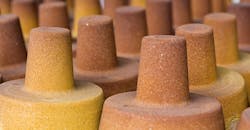Cost, Quality, and Environmental Advances for Cold-Box Coremaking
Q: I’m told that the shell process produces more dimensionally accurate cores, with higher productivity rates and lower labor requirements than the cold-box process. But, with regard to global cost factors, is the shell process the best choice for domestic metalcasters?
A: Over the past few years global competitive pressure and tough economic conditions have forced metalcasters to refine their current processes and develop new technologies that improve productivity and profitability and reduce costs. Thus, rapid advances in core design, production and binder technology is an ongoing project that not only must address customers’ needs but also must be environmentally friendly.
It’s true that the shell process has potential for excellent core surface and good dimensional accuracy in casting due to its rigidity; and it’s high-volume production capability and potential for a semi-automated process have attracted foundry workers worldwide. But at the same time, the requirement for a heated metal tool (450°-650°F) involving natural gas or bottled gas for heating has impacted productivity and cost.
Also, the phenol formaldehyde thermosetting resins needed for the shell process raise environmental concerns not only due to the high resin levels needed for the process (2%- 5%), but also because of the hazardous air pollutant (HAP) characteristic of phenol and formaldehyde.
Since the 1960s, phenolic urethane cold-box (PUCB) binders have gained from significant investments made to convert many shell, hot-box, and sodium-silicate bonded cores to the PUCB process. The economic incentives have been the high-production rate possibilities and reduced cost-per-unit for cold-box coremaking .
Since the 1980s, new cold box processes have been developed and improvements have been made in PUCB formulations. Coremaking machine builders have introduced new models with appropriate gas generation and scrubbing systems that reduce raw material consumption, and allow recycling of some of the consumables (amines.)
Now, there are many ongoing developments in binder technology, not only to improve the performance of the binder but to make it more environmentally friendly. The overwhelming advantage of cold-box process’s “no heat” requirement, and the curing obtained simply by passing an amine catalyst through the cavity, means the core box may be made of wood or plastic to metal for high-production cores, not only creating an environmentally friendly work space but also saving tooling costs.
Several cold-box processes are available, including phenolic urethane/amine, furan/SO2, acrylic/SO2, and sodium silicate/SO2. In general, these processes offer:
1) good dimensional accuracy;
2) excellent surface finish;
3) excellent characteristics for high-volume production due to the short cycle times, allowing for higher production rates;
4) good core and mold shelf life.
Besides heat energy savings and high productivity, cold-box processes have lower gas evolution. Emissions during sand mixing, coremaking, and core storage can be reduced dramatically. Improved environmental characteristics may be seen in the development of “biodiesel” and “aromatic” solvents for lower VOC emissions during coremaking, and lower HAP emissions at pouring, cooling and shakeout.
Also, the cold-box process curing step does not involve a heated tool. A new catalyst, DMPA, has a higher reactivity than TEA. The high reactivity reduces catalyst consumption, results in faster curing, and improves the workplace by reducing odor.
Chemical and equipment advances are not the only improvements in cold-box coremaking. Advanced simulation tools like Arena-flow software, launched in 2001, assists designers with core geometry and multiple cavity core boxes, blow tube selection and location, vent selection and location, and other aspects of tooling design. This allows for more complicated and accurate core and mold production than previously possible, while improving core quality and cycle times, and reduces pattern shop “send backs”.
In addition, binders are rapidly evolving to minimize casting defects, minimize emissions, and produce smooth cast surfaces.
Join the Conversation. Email Your Questions for ASK Chemicals Share your insights, opinions, and elaborate on the questions and the experts' answer(s). You must be logged in to the website in order to post your comments.
